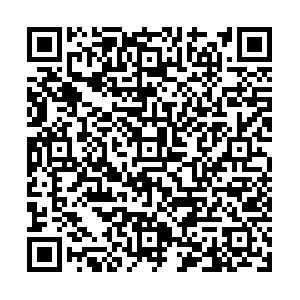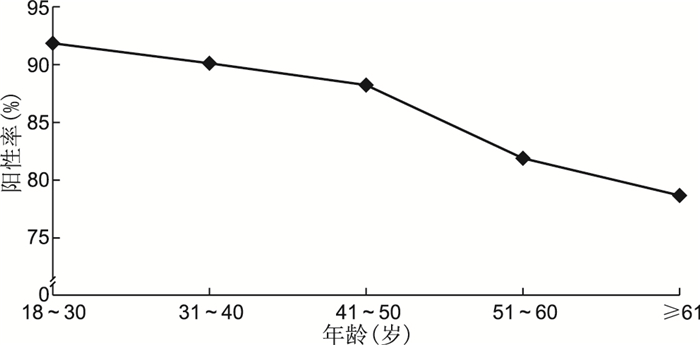Sensitization patterns of inhaled allergens in adults self-reported allergic rhinitis in Zhengzhou area
-
摘要:
目的 了解郑州地区成人自报过敏性鼻炎(allergic rhinitis, AR)患者吸入过敏原致敏谱,分析不同年龄、性别及年份间阳性致敏原的差异,为AR的临床诊治提供参考。 方法 采用17种吸入过敏原试剂对2019年1月—2021年12月就诊于河南省人民医院过敏反应科门诊且自报为AR的成人患者2 305例进行皮肤点刺试验(skin prick test, SPT),比较不同性别、年龄、年份致敏原分布情况,并对阳性率进行分析。 结果 2 305例AR患者SPT阳性率为77.09%,常合并多种过敏原致敏,对4种及以上过敏原阳性者1 137例(49.33%);过敏原阳性率前5位依次为粉尘螨(42.78%)、户尘螨(38.61%)、梧桐花粉(35.27%)、蒿属花粉(34.27%)、葎草花粉(31.63%);18~30岁年龄组过敏原SPT阳性检出率达峰值(91.84%),阳性率随年龄增长而下降;不同性别间粉尘螨、户尘螨、油菜花、葎草花粉SPT阳性率比较差异有统计学意义(均P<0.05);2019—2021年室内吸入过敏原粉尘螨、户尘螨阳性率呈逐年升高趋势,季节性吸入过敏原梧桐花粉、蒿属花粉、葎草花粉阳性率呈逐年下降趋势。 结论 AR患者常合并4种及以上吸入过敏原致敏;18~30岁SPT检出率达峰值;粉尘螨、户尘螨、梧桐花粉、蒿属花粉、葎草花粉是郑州地区成人自报AR患者最常见的致敏原。 Abstract:Objective To investigate the sensitization spectrum of adult self-reported allergic rhinitis (AR) patients in Zhengzhou area, analyze the differences of aeroallergen sensitization rates in different age groups, genders and years, and to provide reference for clinical diagnosis and treatment of AR. Methods Seventeen kinds of inhaled allergen reagents were used to conduct skin prick test (SPT), which was performed in 2 305 adult self-reported AR patients from January 2019 to December 2021 in Henan Provincial People' s Hospital. The distribution of allergens in different genders, ages and years was compared, and the positive rate was analyzed. Results The positive rate of SPT in 2 305 AR patients was 77.09%, which was often complicated with multiple allergens, among them, 1 137 patients (49.33%) were positive for 4 or more allergens. The top 5 allergen positive rates were pollen of dust mite (42.78%), house dust mite (38.61%), Platanus acerifolia pollen (35.27%), Artemisia pollen (34.27%) and Humulus scandens pollen (31.63%). The SPT positive rate of patients aged 18-30 years was the highest (91.84%), and the positive rate decreased with the increase of age. The positive rate of dust mite, house dust mite, Rape pollen and Humulus scandens pollen were statistically significant differences among different genders (all P < 0.05). From 2019 to 2021, the positive rate of dust mites and house dust mites were increased year by year, while the positive rate of Platanus acerifolia pollen, Artemisia pollen and Humulus scandens pollen were decreased year by year. Conclusion AR patients are more likely to be allergic to 4 or more inhaled allergens. The positive rate of SPT was highest in 18-30 years old. Among the common allergens of self-reported AR in adults in Zhengzhou, dust mite, household dust mite, Platanus acerifolia pollen, Artemisia pollen and Humulus scandens pollen are the most common allergens. -
Key words:
- Allergic rhinitis /
- Inhaled allergen /
- Skin prick test /
- Sensitization
-
表 1 不同种类吸入过敏原分布情况
Table 1. Distribution of different kinds of inhaled allergen
吸入过敏原 阳性例数 阳性率(%) 粉尘螨 986 42.78 户尘螨 890 38.61 屋尘 657 28.51 狗毛皮屑 511 22.17 猫毛皮屑 530 22.99 蟑螂 540 23.43 蚕丝 337 14.62 黑曲霉 172 7.46 链格孢 200 8.68 枝状枝孢 182 7.89 梧桐花粉 813 35.27 油菜花 683 29.63 杨树花粉 543 23.56 圆柏花粉 708 30.72 蒿属花粉 790 34.27 豚草花粉 704 30.54 葎草花粉 729 31.63 任1项阳性 1 777 77.09 单1过敏原 214 9.28 合并2种过敏原 327 14.19 合并3种过敏原 369 16.01 合并4种及以上过敏原 1 137 49.33 表 2 不同性别间吸入过敏原SPT阳性情况比较[例(%)]
Table 2. Comparison of SPT positivity of inhaled allergens between different genders[cases(%)]
吸入过敏原 例数 男性(n=1 129) 女性(n=1 176) χ2值 P值 粉尘螨 986 516(45.70) 470(39.97) 7.748 0.005 户尘螨 890 466(41.28) 424(36.05) 6.624 0.010 屋尘 657 332(29.41) 325(27.63) 0.723 0.395 狗毛皮屑 511 238(21.08) 273(23.21) 1.520 0.218 猫毛皮屑 530 260(23.03) 270(22.96) 0.002 0.968 蟑螂 540 273(24.18) 267(22.70) 0.784 0.376 蚕丝 337 179(15.85) 158(13.44) 2.701 0.100 黑曲霉 172 91(8.06) 81(6.89) 1.147 0.284 链格孢 200 93(8.24) 107(9.10) 0.539 0.463 枝状枝孢 182 95(8.41) 87(7.40) 0.819 0.366 梧桐花粉 813 414(36.67) 399(33.93) 1.896 0.169 油菜花 683 356(31.53) 327(27.81) 3.836 0.047 杨树花粉 543 285(25.24) 258(21.94) 3.165 0.075 圆柏花粉 708 350(31.01) 358(30.44) 0.061 0.805 蒿属花粉 790 397(35.16) 393(33.42) 0.779 0.377 豚草花粉 704 362(32.06) 342(29.08) 2.415 0.120 葎草花粉 729 381(33.75) 348(29.59) 4.598 0.032 表 3 不同年龄、性别吸入过敏原阳性率(%)
Table 3. Positive rate of inhaled allergens in different age and sex groups(%)
年龄(岁) 性别 例数 粉尘螨 户尘螨 梧桐花粉 蒿属花粉 葎草花粉 18~30 男性 436 48.16 43.43 40.06 38.99 38.76 女性 434 42.86 41.24 38.25 37.79 32.72 31~40 男性 319 46.73 42.95 37.93 37.62 35.42 女性 314 40.58 34.08 36.94 35.67 31.53 41~50 男性 199 44.51 42.21 32.16 34.67 33.67 女性 207 40.13 33.82 31.88 28.50 28.02 51~60 男性 111 38.74 36.04 27.03 25.23 25.23 女性 154 34.42 29.87 24.03 22.73 16.23 ≥61 男性 64 42.19 26.96 29.69 26.56 18.75 女性 67 29.85 31.34 20.89 23.88 22.39 -
[1] 杨一兵. 2005—2011年中国主要城市自我报告过敏性鼻炎患病率增加[J]. 中华预防医学杂志, 2019, 53(4): 691.YANG Y B. Prevalence of self-reported allergic rhinitis increased in major Chinese cities from 2005 to 2011[J]. Chin J Prev Med, 2019, 53(7): 691. [2] 丁敏, 潘家华. 儿童变应性鼻炎诊疗进展[J]. 中华全科医学, 2018, 16(12): 1958-1959. http://www.zhqkyx.net/article/id/c74bd827-27bd-45e4-8c0d-dd2eabf9078eDING M, PAN J H. Progress in diagnosis and treatment of allergic rhinitis in children[J]. Chinese Journal of General Practice, 2018, 16(12): 1958-1959. http://www.zhqkyx.net/article/id/c74bd827-27bd-45e4-8c0d-dd2eabf9078e [3] BROẐEK J L, BOUSQUT J, AGACHE I, et al. Allergic Rhinitis and its Impact on Asthma (ARIA) guidelines-2016 revision[J]. J Allergy Clin Immunol, 2017, 140(4): 950-958. doi: 10.1016/j.jaci.2017.03.050 [4] LARSEN J N, DREBORG S. Standardization of allergen extracts[J]. Methods Mol Biol, 2019, 2020: 63-76. [5] GUPTA N, AGARWAL P, SACHDEV A, et al. Allergy testing: An overview[J]. Indian Pediatr, 2019, 56(11): 951-957. doi: 10.1007/s13312-019-1652-x [6] 尹佳. 北京协和医院变应原制剂应用指南[M]. 北京: 中国协和医科大学出版社, 2014: 17-21.YIN J. Guidelines for the application of allergens in Peking Union Medical College Hospital[M]. Beijin: Peking Union Medical College Press, 2014: 17-21. [7] POPOV T A, PASSALACQUA G, GONZÁLEZ-DÍAZ S N, et al. Medical devices in allergy practice[J]. World Allergy Organ J, 2020, 13(10): 100466. DOI: 10.1016/j.waojou.2020.100466. [8] 张愈正, 伍莹, 邹天添, 等. 渝西南地区变应性鼻炎吸入性变应原谱分析[J]. 中国耳鼻咽喉颅底外科杂志, 2022, 28(1): 22-27. https://www.cnki.com.cn/Article/CJFDTOTAL-ZEBY202201004.htmZHANG Y Z, WU Y, ZOU T T, et al. Characteristic of aeroallergens in allergic rihinitis patients of southwest Chongqing[J]. Chin J Otorhinolaryngol Skull Base Surg, 2022, 28(1): 22-27. https://www.cnki.com.cn/Article/CJFDTOTAL-ZEBY202201004.htm [9] 马婷婷, 王洪田, 陈艳蕾, 等. 北京地区门诊患者常见吸入过敏原致敏谱[J]. 中华临床免疫和变态反应杂志, 2021, 15(2): 136-143. doi: 10.3969/j.issn.1673-8705.2021.02.002MA T T, WANG H T, CHEN Y L, et al. Sensitization spectrum of inhaled allergens in outpatients in Beijing area[J]. Chin J Allergy Clin Immunol, 2021, 15(2): 136-143. doi: 10.3969/j.issn.1673-8705.2021.02.002 [10] LOU H F, MA S Y, ZHAO Y, et al. Sensitization patterns and minimum screening panels for aeroallergens in self-reported allergic rhinitis in China[J]. Sci Rep, 2017, 7(1): 9286. doi: 10.1038/s41598-017-10111-9 [11] WANG X Y, MA T T, WANG X Y, et al. Prevalence of pollen-induced allergic rhinitis with high pollen exposure in grasslands of northern China[J]. Allergy, 2018, 73(6): 1232-1243. doi: 10.1111/all.13388 [12] 阳玉萍, 麦麦提·伊敏, 王燕, 等. 新疆维吾尔自治区变应性鼻炎患者吸入变应原谱变化分析[J]. 中华耳鼻咽喉头颈外科杂志, 2017, 52(5): 355-360. doi: 10.3760/cma.j.issn.1673-0860.2017.05.007YANG Y P, MAIMAITI Y M, WANG Y, et al. Changing analysis of allergic rhinitis inhalant allergen spectrum in Xinjiang region[J]. Chin J Otorhinolaryngol Head Neck Surg, 2017, 52(5): 355-360. doi: 10.3760/cma.j.issn.1673-0860.2017.05.007 [13] SRISUWATCHRRI W, KWANTHONG P, BUNNAG C, et al. Association between skin prick test and serum specific immunoglobulin E to American cockroach allergens in allergic rhinitis patients[J]. Allergol Immunopathol (Madr), 2020, 48(2): 170-174. doi: 10.1016/j.aller.2019.07.007 [14] TENG B S, ZHANG X S, YI C, et al. The Association between ambient air pollution and allergic rhinitis: Further epidemiological evidence from Changchun, Northeastern China[J]. Int J Environ Res Public Health, 2017, 14(3): 226. doi: 10.3390/ijerph14030226 [15] 王孟, 郑铭, 王向东, 等. 中国过敏性鼻炎流行病学研究进展[J]. 中国耳鼻咽喉头颈外科, 2019, 26(8): 415-420. https://www.cnki.com.cn/Article/CJFDTOTAL-EBYT201908004.htmWANG M, ZHENG M, WANG X D, et al. Progress in epidemiology of allergic rhinitis in China[J]. Chin Arch Otolaryngol Head Neck Surg, 2019, 26(8): 415-420. https://www.cnki.com.cn/Article/CJFDTOTAL-EBYT201908004.htm [16] 娄鸿飞, 马思远, 赵岩, 等. 京津冀地区自报过敏性鼻炎病人吸入过敏原检测临床相关性分析[J]. 首都医科大学学报, 2017, 38(5): 665-670. https://www.cnki.com.cn/Article/CJFDTOTAL-SDYD201705009.htmLOU H F, MA S Y, ZHAO Y, et al. Sensitization patterns for aeroallergens in self-reported allergic rhinitis within Beijing, Tianjin, and Hebei region[J]. Journal of Capital Medical University, 2017, 38(5): 665-670. https://www.cnki.com.cn/Article/CJFDTOTAL-SDYD201705009.htm [17] 王阳, 马思远, 王成硕, 等. 北京地区自报过敏性鼻炎患者临床特征与吸入性变应原分析[J]. 中国耳鼻咽喉头颈外科, 2019, 26(8): 405-409. https://www.cnki.com.cn/Article/CJFDTOTAL-EBYT201908002.htmWANG Y, MA S Y, WANG C S, et al. Clinical features and aeroallergens analysis of selfreported allergic rhinitis patients in Beijing[J]. Chin Arch Otolaryngol Head Neck Surg, 2019, 26(8): 405-409. https://www.cnki.com.cn/Article/CJFDTOTAL-EBYT201908002.htm [18] KIM J H, KIM S A, KU J Y, et al. Comparison of allergens and symptoms in patients with allergic rhinitis between 1990s and 2010s[J]. Allergy Asthma Clin Immunol, 2020, 16(1): 58. [19] LI Y S, HU H S, ZHANG T, et al. Increase in indoor inhalant allergen sensitivity during the COVID-19 pandemic in South China: A cross-sectional study from 2017 to 2020[J]. J Asthma Allergy, 2021, 14: 1185-1195. [20] 中华耳鼻咽喉头颈外科杂志编辑委员会鼻科组, 中华医学会耳鼻咽喉头颈外科学分会鼻科学组. 中国变应性鼻炎诊断和治疗指南(2022年, 修订版)[J]. 中华耳鼻咽喉头颈外科杂志, 2022, 57(2): 106-129. https://www.cnki.com.cn/Article/CJFDTOTAL-YRBH202202017.htmSubspecialty Group of Rhinology, Editorial Board of Chinese Journal of Otorhinolaryngology Head and Neck Surgery, Subspecialty Group of Rhinology, Society of Otorhinolaryngology Head and Neck Surgery, Chinese Medical Association. Chinese guidelines for diagnosis and treatment of allergic rhinitis (2022, revision)[J]. Chin J Otorhinolaryngol Head Neck Surg, 2022, 57(2): 106-129. https://www.cnki.com.cn/Article/CJFDTOTAL-YRBH202202017.htm -





 下载:
下载:



